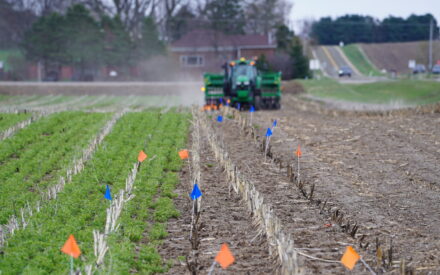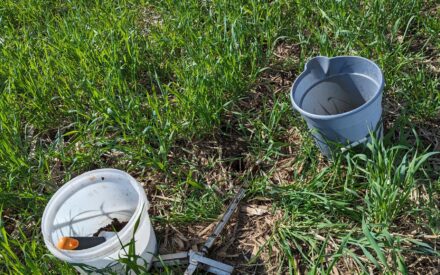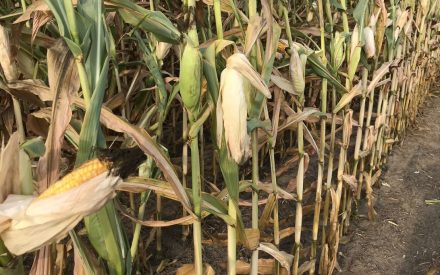This article originally appeared in the Wisconsin State Farmer.
When it rains, it pours, and unfortunately for much of the upper Midwest, this was a reality in spring and early summer of 2024. In Wisconsin, it seemed like every passing rain cloud dropped an inch or more of rain, and those clouds just kept coming. Combine record moisture in some areas with high humidity and clouds, and it was the perfect storm for slugs, molds, and diseases to infiltrate our crop fields and cause damage. While some of these pests have a brief window of damage, mold and fungi can be the gift that keeps on giving.
Even when mold growth ceases, they can leave behind potentially toxic compounds in mycotoxins. We tend to focus on just a few mycotoxins that cause major economic issues in human and livestock feed ingredients. Deoxynivalenol (DON/Vomitoxin), zearalenone (ZON) and fumonisins are among the most challenging toxins on our radar and can create major challenges in dairy cattle diets. Increased feed refusals, milk production loss, abortions and poor reproductive performance are key issues that mycotoxins can cause in lactating cow systems.

One of the most frustrating aspects of mycotoxins is we often do not know they are present in grains and forages. Visible mold on a plant, grain or in silage is a poor indicator of mycotoxin contamination, and mycotoxins may exist where we do not have visual cues. Oftentimes, testing for mycotoxins only occurs if we see reduced animal productivity, reproductive issues, or compromised animal health. Higher rates of corn silage in cow diets are common, which means the presence of mycotoxins in our corn grain and silage has a more pronounced effect on animal health and well-being.
Prevention of mold and fungal growth on corn plants and grain is a near impossible task. We can minimize further contamination of silage and limit impact by taking key management steps:
- Monitor the weather: Mold challenges are always top of mind in wet, humid weather, but they can develop under varying weather conditions. Recognize what challenges exist in your region of the country during the growing season.
- Assess plant health before harvest: Identify fields with insect, disease, or weather damage as this damage can allow pathogens to affect the plant. Monitor problem fields closely and harvest as soon as possible to limit additional damage.
- Practice good harvest management: Many molds may not affect the plant but are brought in from the field during harvest. Harvesting and ensiling corn silage at the proper moisture based on silage structure, chopping silage to the appropriate length to ensure optimum silage density, quick silo filling and proper packing allows the silage to ferment more quickly, dropping silage pH which in turn limits additional mold growth and mycotoxin production.
- When in doubt – test: Or, when not in doubt, test. While there is cost to testing, it is quickly offset by improving reproduction, milk production, and protecting animal health. Proactive identification of mycotoxin presence allows for the inclusion of toxin binders in the diet or dilution/elimination of the affected feed that can improve animal performance.
It is too late to change some aspects of corn silage production from the agronomic sense this growing season – there are lessons we can learn to impact future crops:
- Identify problem fields: Many of the fungi involved with mycotoxin challenges can overwinter in crop residues. If you had a challenge in a specific field, consider removing some residues or rotate to non-host crops. This will not eliminate the presence of toxin causing molds but is a step to reduce the pressure.
- Maintain soil fertility: Proper plant nutrition goes a long way in helping that plant deal with stressors, and maintaining fertility based on a soil test boosts overall plant resilience.
- Focus on hybrid selection: Identify traits that improve disease and insect resistance which can limit plant damage that can lead to mold growth and mycotoxin contamination. Further, select hybrids with maturities that best fit your growing season to ensure appropriate dry down for prompt harvest.
- Have a plan to scout for disease: Crop disease does not equal mycotoxins, but stressed plants are more susceptible to secondary infections. Recognize when a field might be at risk for disease and remain proactive in your management.
Once mycotoxins have contaminated a feed source, we cannot eliminate them, only manage them. Work with a nutritionist to determine the best plan of action for mitigating mycotoxin risk and identifying classes of livestock that are less sensitive to mycotoxins. As with most management challenges, an ounce of prevention is worth a pound of cure, so remaining vigilant is necessary to limit the effect mycotoxins have on your farm.
Published Sept. 30, 2024

 ▶ Unlocking the Potential of Biological Nitrogen Fixation in Corn
▶ Unlocking the Potential of Biological Nitrogen Fixation in Corn ▶ Considerations for 2026 Seed Selection
▶ Considerations for 2026 Seed Selection ▶ Evaluating MRTN Rates for Corn Grain and Silage After Manure Application
▶ Evaluating MRTN Rates for Corn Grain and Silage After Manure Application ▶ Practices to Optimize the Nutritive Value of Corn Silage
▶ Practices to Optimize the Nutritive Value of Corn Silage


